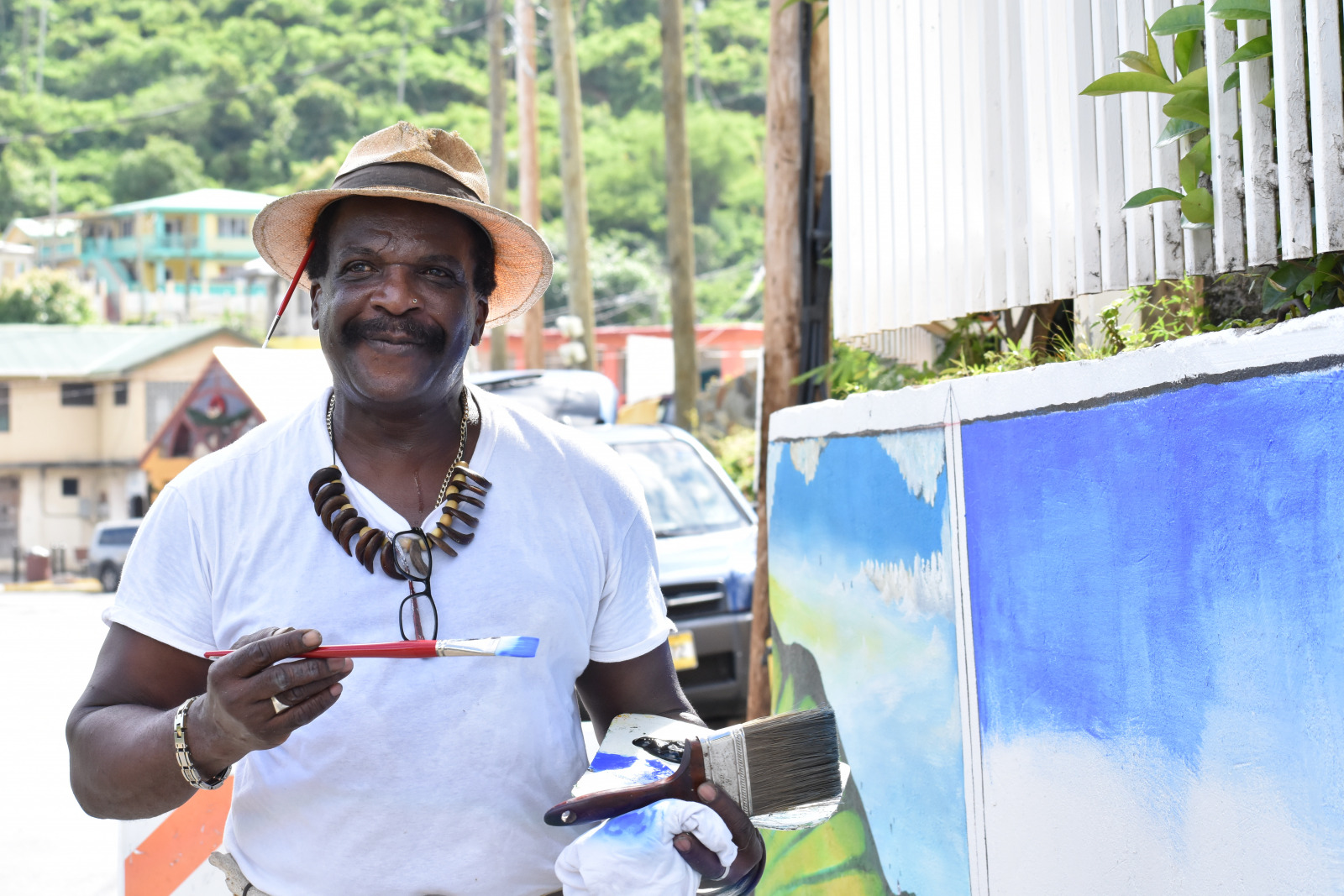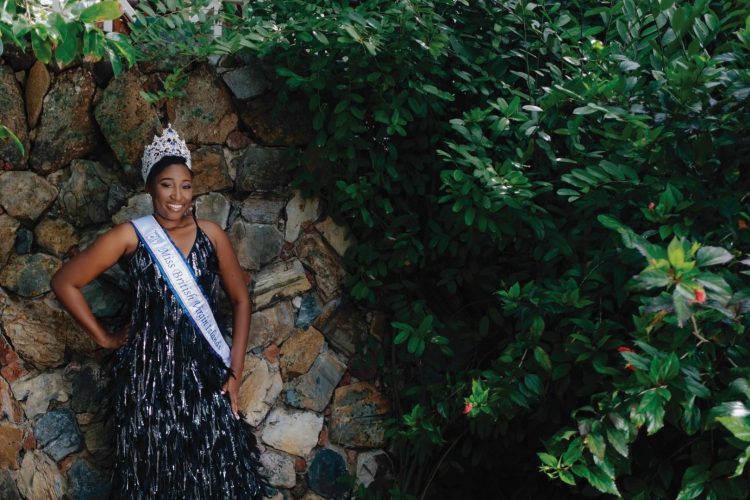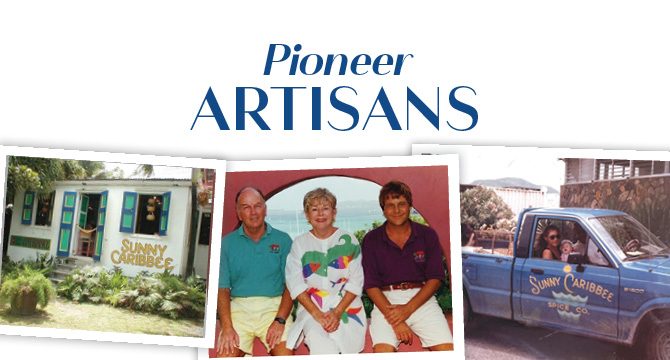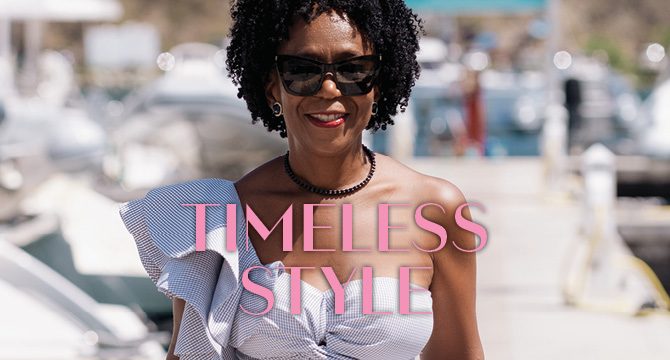Each of the four artists interviewed for this article uses their art to express their love of various elements of BVI; from our history and culture to the people, and even visitors to our shores.
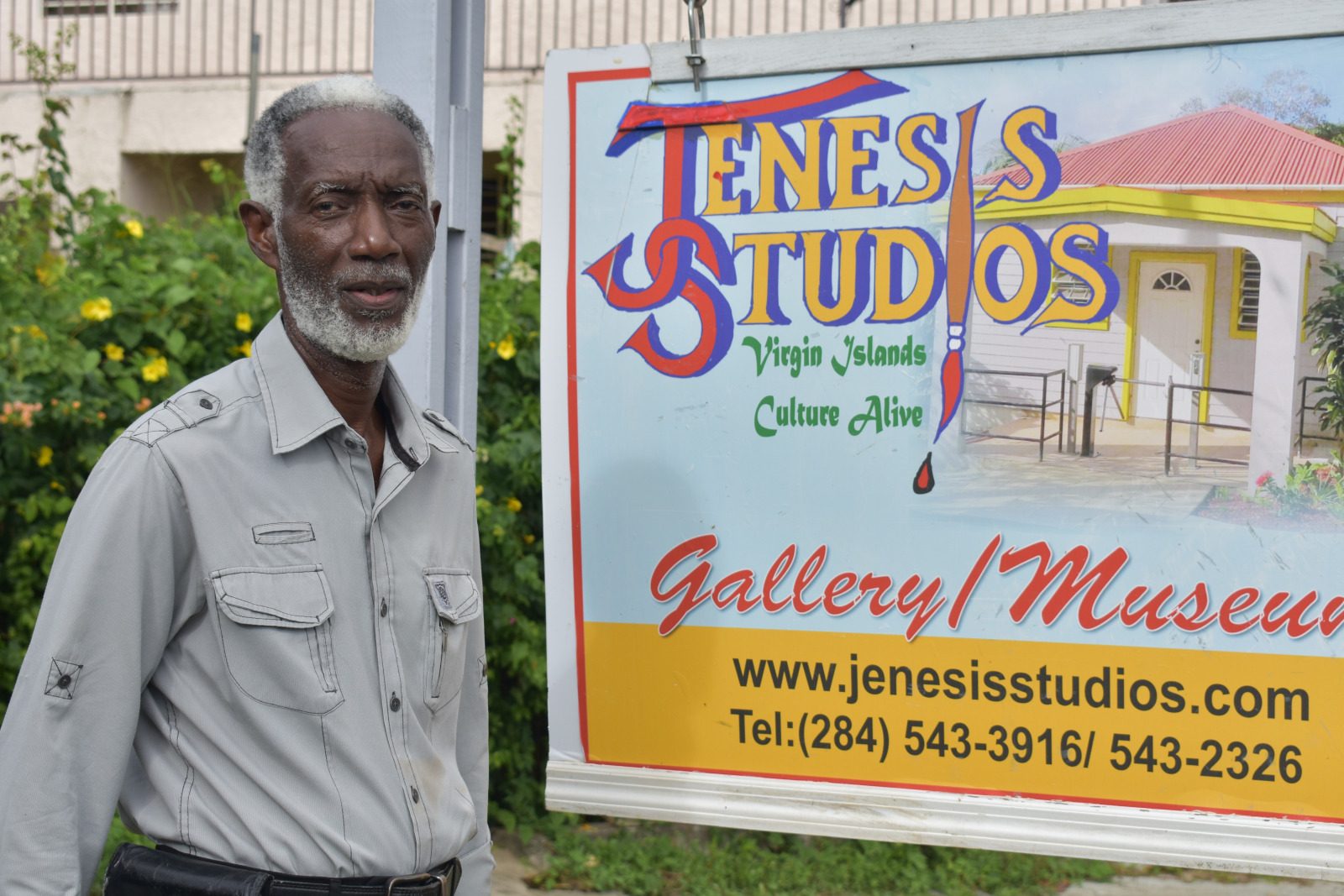
Reuben was born, raised and still lives in Great Mountain, Tortola and has been painting for 45 years.
It was at his first family home in Great Mountain where he’d watch his mom use the kitchen floor to draw. Back then the kitchen floors were hard-packed dirt and Reuben’s mother used sharp sticks to draw figures into the floor.
“There wasn’t any media to use like paper and canvas. If you wanted to draw, you drew on a slate in school, or a piece of brown paper, from which you had purchased flour or cornmeal. Pencils weren’t easily available at the time so we would use charcoal,” said Vanterpool.
One of Reuben’s teachers encouraged him by asking him to help draw certain things on the blackboard. “The children would say it looks nice and I got the feeling that I could draw. I believe a person can inherit talent, it only comes to fruitfulness if it is developed.”
And that development opportunity came when Anne Tabor from Voluntary Service Overseas International arrived in BVI to establish the very first art programme in 1966.
It was an after-school programme for current students, but Reuben had already graduated. After some begging, he was allowed to join the small group of four. He recalls that Ms Tabor was surprised that in only after a few months of instruction that the group had improved their skills so much that they were able to register and pass the General Certificate of Education in Art, administered through the UK. This was a major accomplishment for the students who had never had any formal art training prior to Ms Tabor’s arrival.
Reuben went on to the Leewards Islands Teachers Training College to get a formal certification as a teacher but took time doing correspondence courses in art. He eventually went to Bretton Hall College, at the University of Leeds in 1977 where he studied art. After completing his degree, he joined the BVI High School to set up an Art Department and worked as Department Head for 12 years.
What does art mean to Reuben?
“It is a very important avenue of expression, of messaging. But you give long term messages in art,” he said.
Reuben’s focus in art is Virgin Islands heritage. He wants his art to be a probe into the Virgin Islands way of life that is depicted in the paintings, as well as appreciating what they see too. This is why Reuben says he paints images of the way BVI was and the people who lived at that time, to “show the kind of work they did, the stress they went through…everything that touched us.”
“I wanted to record us graphically. We have historians who write. We have literary artists who write poetry and novels, and they all help tell the story of the Virgin Islands. But they say one picture is worth many many words. [Art] helps you understand quicker. That’s my contribution.”
Reuben’s preferred medium is paint and canvas, and also works with pottery and papier-mache. Interesting to note is that Reuben’s second degree is in design and technology, and he now uses those technical skills in his art as he has begun creating metal sculptures.
He describes his highest point as an artist as being the joy he felt after establishing his own museum called Jenesis Studios, also on Great Mountain. Having his own space means he can display his work on his own terms.
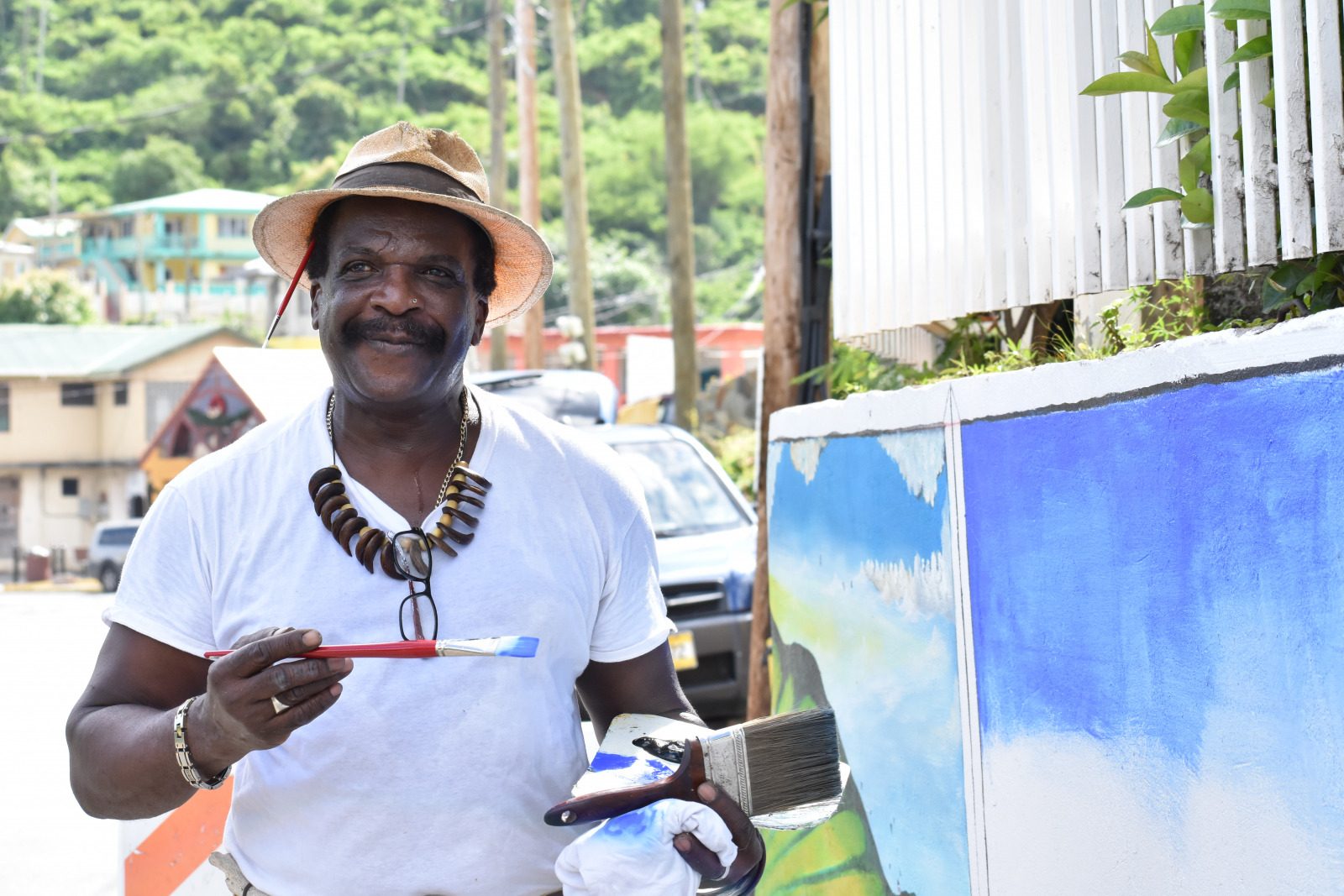
Bing was born and raised and still lives in Fat Hog’s Bay, Tortola. Bing says his mom nicknamed him “Bien” when he was a child because he was ‘good’ and never cried. Throughout his childhood, he drew “anything that anyone would mention.” He drew on the blackboard and made his classmates laugh.
During his 20s, he built Bing’s Drop Inn, a restaurant that now doubles as his art studio, after which he moved to St. Thomas, “to explore”, he says. He then moved on to New York where he received his first and only formal training in art doing silk screening. Bing says he developed the skill of painting by “just wanting to be an artist”.
After moving back to Tortola in the 90s, he sold his first painting. Because he had no money, he had to use his wooden cutting board to make a canvas. The quaint painting can still be found at Bing’s Drop Inn today; he traded that first painting with the owner for a new one.
Bing credits his cousin Russell Lettsome and uncle Davin Frett, both artists, for inspiring and encouraging his art. Bing recalls his uncle saying before he died: “Bing, you’re getting better than me.” He also is grateful for his wife, Xiomara Grossett, who is also an artist and fashion designer.
What does art mean to Bing?
“Art is a way of knowing, knowing that all things are possible.”
Bing says he has always been fascinated with colours and is motivated to see what the final product will be. “I love colours…if it’s a dark day, you can have a bright beautiful day by having beautiful colours around you.”
His favourite thing to paint is clouds because they change constantly.
“It’s for the now. You see everything in the clouds. You see all sorts of things in the cloud that you’re like ‘wow’, but it lasts for a second…brings you more to the spiritual side of life.”
While Bing’s preferred medium is paint, he also makes bags and jewellery from calabash and also designs and sews clothes.
Bing says his highest point as an artist happens every time he paints, when he “connects with the spiritual side of the Universe”.
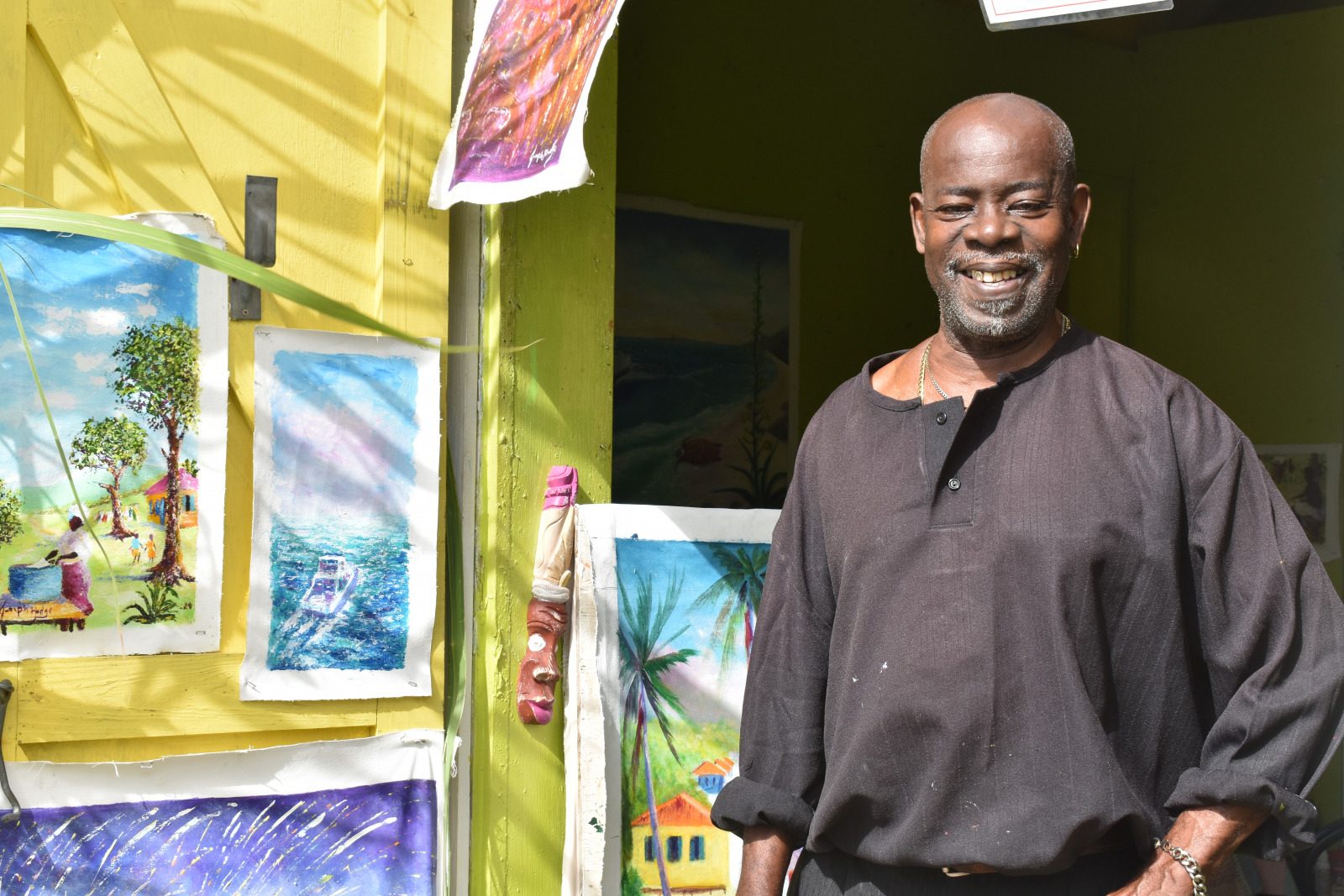
Kudjo hails from the Greater Virgin Islands, both British and US. He was born in Curacao while his father worked as a diver helping to build the floating bridge. Kudjo grew up between Tortola, St. Thomas and St. Maarten, where at age three, he remembers Teacher Julie bringing “pat” or clay for him to play with. That’s when his love of art began.
Something happened at age eight that changed how the artist saw life, and would later influence his art. While living with his grandmother in St. Thomas, Kudjo was really into comic books at the time. One day, as he returned home from school, he met a fire in the backyard. His grandmother was burning his comic book collection and told him that he should “read books with sense”. And so he did. One of the first books he read was A Separate Reality by Carlos Castaneda. He was excited first by the book’s cover, a colourful picture collage with various natural elements.
He always drew in his school books, but began painting in his teens and was further inspired by artist Marian Helm, and recalls peeking into her house just to admire her huge wall to wall paintings.
Kudjo likes colours and texture and prefers using a palette knife and acrylics. He describes his paintings as cultural and impressionist.
“My passion for art is to speak through my heart. I paint what BVI used to be…I paint the colonized situation that took place in the Caribbean…what I would paint, [other artists] would not. Because they have not seen it. You can only paint what you see, or what you experience. It’s more valuable to you than what was. When I started to paint, it wasn’t about money, it was about cultural pride.”
What does art mean to Kudjo?
“Art is life. It’s expression. It’s a way of life. And it’s passion. Because I learned to love. I’m a colourful person.”
Kudjo’s high point as an artist was when he travelled to Suriname for CARIFESTA in 1981 to represent BVI artists. This is where he spent some time amongst the Saramaka people.
Lutia Tai Durante
Lutia Durante hails from Long Look, Tortola, where he created his first pieces of artwork from chalk. Lutia says as a child his reward for sweeping the yard would be chalk. Soon after he graduated to coal.
Lutia went to neighbouring St. Thomas when he was five where he did most of his schooling and also spent some time in New York. It wasn’t until his return to BVI in 1992 that he began painting – 40 canvases that summer alone.
Lutia was very private about his painting until one day, a chance visit by some friends who came to check up on him at his home, ended up seeing some of his paintings.
“I got involved in [painting] just for fun. It wasn’t about money.”
Clearly.
Lutia recalls his meeting with Keith Richards of the Rolling Stones, when instead of selling his paintings, he made a trade with the guitarist for some signed albums.
While the artist didn’t receive formal training before his art career began, he did a short stint at The School of the Museum of Fine Arts at Tufts University in Boston. Here is where he says he experienced his most exciting moment as an artist. Lutia says he only spent a short time there because the professors there told him: “If you continue painting how you paint, we can’t teach you anything.”
“Painting is God’s gift. I never questioned it…I let it flow how it comes. I can’t stop it. I can’t control it.”
What does art mean to Lutia?
“It’s like coming home after work to relax by watching TV, listening to music or reading a good book, or having a good conversation. This is what art does to me.”
“Art is love…It’s like letting off good steam. Especially the negative steam. I don’t like people telling me my art is good too much. Tell me what’s wrong. Not that I won’t go back and change it for you.”
Lutia also says that he likes history and paints images of the BVI he remembers from his past and the stories his mom and grandmother would tell him.
“We have kids that really don’t know the history and they don’t really want to read a book or listen to audio, so if they can see it on the walls, then they will learn what used to happen here.”
Lutia, whose preferred medium is oil on canvas, says he is “stuck back in the 60s” and paints architecture, memories, animals, and landscapes, he doesn’t paint faces. Lutia says he prefers to paint people with their head turned away, their silhouettes and profiles.
Lutia’s advice for youth and other artists is to be themselves.
“Be you when you paint. Don’t let anyone stop you. Because there’s somebody out there looking for you. Be you. You make the world by being you.”
The artists were interviewed separately for this article, but all of them had similar advice to aspiring artists, that is, to pursue your passion, do it for love, and never stop – just as they did.
[ts_fab]
